Automatic Heating and Air Conditioning System (Climate Control)
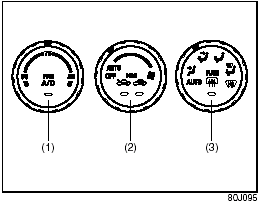
Description of Controls
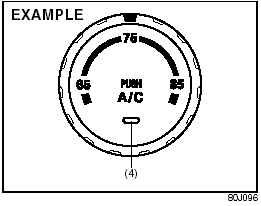
Temperature selector/Air conditioning switch (1)
This is used to select the temperature by turning the selector.
Also, this is used to turn on and off the air conditioning system by pushing the switch.
To turn on the air conditioning system, push in the switch and the A/C indicator light (4) will come on. To turn off the air conditioning system, push in the switch again and the A/C indicator light (4) will go off.
NOTE:
If the A/C indicator light (4) blinks, there is
a problem in the heating system and/or air
conditioning system. You should have the
system inspected by an authorized
SUZUKI dealer.
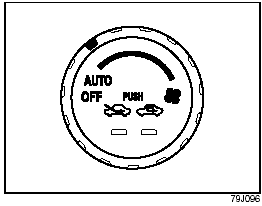
Blower speed selector/Air intake selector (2)
This is used to turn on the blower and to select blower speed.
If the selector is in “AUTO” position, the blower speed will vary as the climate control system maintains the selected temperature.
Also, this is used to select the following modes by pushing the selector.
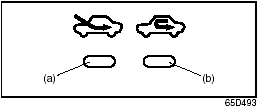
FRESH AIR
When this mode is selected, the indicator light (a) will come on and outside air is used.
RECIRCULATED AIR
When this mode is selected, the indicator light (b) will come on, outside air is shut out and inside air is recirculated. This mode is suitable when driving through the polluted air such as a tunnel, or attempting to quickly cool down.
“FRESH AIR” and “RECIRCULATED AIR” are switched alternately each time the air intake selector is pushed.
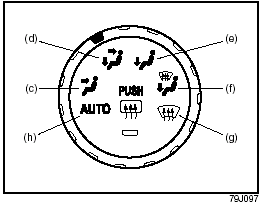
Air flow selector (3)
AUTO (h)
Temperature-controlled air comes out of various outlets automatically.
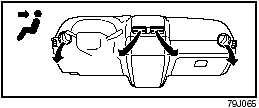
Ventilation (c)
Temperature-controlled air comes out of the center and side air outlets.
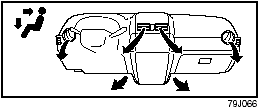
Bi-level (d)
Temperature-controlled air comes out of the floor outlets and cooler air comes out of the center and side outlets. When the temperature selector (1) is in the fully COLD position or fully HOT position, however, the air from the floor outlets and the air from the center and side outlets will be the same temperature.
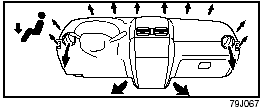
Heat (e)
Temperature-controlled air comes out of the floor outlets and the side outlets, also comes out of the windshield defroster outlets and the side defroster outlets slightly.
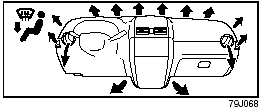
Heat & defrost (f)
Temperature-controlled air comes out of the floor outlets, the windshield defroster outlets, the side defroster outlets and the side outlets.
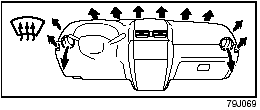
Defrost (g)
Temperature-controlled air comes out of the windshield defroster outlets, the side defroster outlets and the side outlets.
NOTE:
When the air flow selector (3) is turned
either to “Heat & defrost (f)” or “Defrost
(g)”, the air conditioning system will come
on and the “FRESH AIR” mode will be
selected automatically. But in very cold
weather, the air conditioning system will
not turn on.
System Operating Instructions
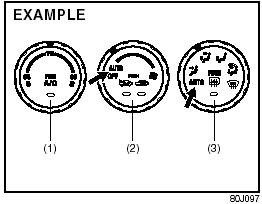
Automatic operation
You can let the climate control system work automatically. To set the system in fullyautomatic operation, follow the procedure below.
1) Set the desired temperature by turning the temperature selector (1).
2) Turn the blower speed selector (2) to the “AUTO” position.
3) Turn the air flow selector (3) to the “AUTO” position.
Then the blower speed selector/air intake selector (2) and air flow selector (3) are controlled automatically to maintain the set temperature.
The air conditioning switch (1) is to be selected manually according to your taste.
When you turn the air conditioning switch off, the climate control system cannot lower the inside temperature below outside temperature.
To turn the climate control system off, turn the blower speed selector (2) to the “OFF” position
NOTE:
• To find your comfortable zone, start with
the 75°F (25°C) setting.
• If you turn the temperature selector (1) to the highest or lowest limit, the climate control system will operate at the maximum cooling or heating and the blower will run at nearly full speed.
• To avoid blowing cold air in cold weather or hot air in hot weather, the system will delay turning on the blower until warmed or chilled air is available.
• If your vehicle has been left in the sun with the windows closed, it will cool faster if you open the windows briefly.
• Even under the automatic operation, you can set some of the blower speed selector/ air intake selector (2) and air flow selector (3) into manual mode. Then the manually selected function is maintained preferentially, and the other functions remain under automatic operation.
• To return the air intake selector (2) to automatic operation when both the blower speed selector (2) and the air flow selector (3) are in the “AUTO” position, turn either the selector (2) or (3) to a position other than “AUTO”, then turn to the “AUTO” position again.
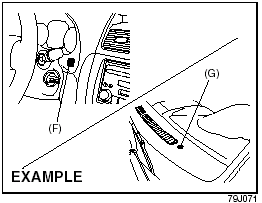
Be careful not to cover the interior temperature sensor (F) between the steering wheel and the climate control panel, or the solar sensor (G) located at the top of the driver’s side dashboard. These sensors are used by the automatic system to regulate temperature.
Manual operation
You can manually control the climate control system. Set the selectors to your desired position.
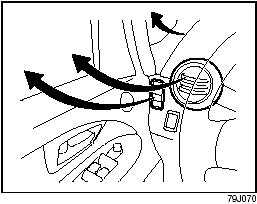
NOTE:
If you need maximum defrosting:
• set the air flow selector to “DEFROST”
(the air conditioning system will come on
and the “FRESH AIR” mode will be
selected automatically),
• set the blower speed selector to HIGH,
• adjust the temperature selector to the
HOT end, and
• adjust the side outlets so the air blows
on the side windows.
Maintenance
If you do not use the air conditioner for a long period, such as during winter, it may not give the best performance when you start using it again. To help maintain optimum performance and durability of your air conditioner, it needs to be run periodically.
Operate the air conditioner at least once a month for one minute with the engine idling. This circulates the refrigerant and oil and helps protect the internal components.
NOTE:
Your vehicle uses the air conditioning
refrigerant HFC-134a, commonly called
“R-134a”. R-134a replaced R-12 around
1993 for automotive applications. Other
refrigerants are available, including recycled
R-12, but only R-134a should be used
in your vehicle.
CAUTION:
Using the wrong refrigerant may
damage your air conditioning system.
Use R-134a only. Do not mix or replace the R-134a with other refrigerants.
See also:
2007 Suzuki Grand Vitara review
The small-SUV market is a tough league to play in, full of worthy contenders
such as the Ford Escape, Toyota RAV-4, Honda CR-V, Mitsubishi Outlander, Jeep
Compass and the Korean twins, the Hyundai ...
Overview
Recognized by AutoPacific as the "ideal" compact SUV/off-road vehicle, Suzuki
Grand Vitara surpasses other SUVs in its size and price category in balancing
off-road capability with the v ...
Fuel Recommendation
Your vehicle requires regular unleaded
gasoline with a minimum rating of 87 pump
octane ((R + M)/2 method). In some areas,
the only fuels that are available are oxygenated
fuels.
Oxygenated f ...
